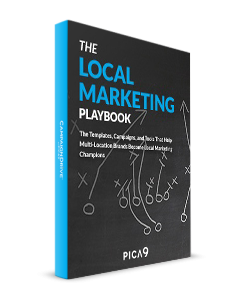You’ve heard the hype—and the horror stories. Now it’s time to get to work using AI features in your local marketing system to save your brand team precious time; improve the quality of creative work at the local level, and create a culture of continuous learning and improvement across the brand, by implementing a digital asset management (DAM) for local marketing to streamline creative operations and maintain brand consistency..
In this post, you’ll discover:
- 3 warning signs that signal a brand is falling behind the AI times.
- 2 intelligent features your local marketing system should be delivering today.
- 3 future-proofing moves you should make in the next 12-18 months to make sure your brand keeps pace with the ever-accelerating AI trend.
AI in Local Marketing: An Overview
There seems to be no end to the potential that AI experts claim for machine-learning and generative technologies, and the realm of local marketing has not escaped the hype. We’ve heard tales of AI helping local marketers to micro-target their best customers to increase sales with almost effortless ease. We’ve been treated to visions of a future in which marketing has by and large ceased to be a human function entirely, as machines learn from what people have purchased today what they will, without question, purchase tomorrow. It sounds intriguing, and a little bit breathless.
But before we dive into the deep end of this AI pool, let’s recall that most technologies go through what the famous futurist Geoffrey Moore called “The Trough of Defeated Expectations”: that period of time when reality falls far short of the hype and investments made with such optimism are written off as failures with brutal, sudden swiftness. And those rapid swings—complete with major investments and huge amounts of training time, often lead local marketers to conclude that they may be better served by taking small steps, with proven tools. And who can blame them?
The good news is, that those small but meaningful AI advances are already showing up in the local marketing platform. And while they aren’t creating miracles, they are certainly cause for celebration—because franchise marketing automation tools they are reducing labor costs, shortening turnaround times, and improving creative quality and brand compliance—all without imposing new training burdens at all.
Is Your Brand Lagging Behind the AI Curve?
Another meaning we might consider for the AI acronym is “Anxiety Indicator”. That’s because many brand managers spend more time worrying about the implications of implementing AI than they do actually putting practical, first-generation franchise marketing automation tools tools to work.
Here are three telltale signs that your local marketing operation is beginning to fall behind the AI curve—all based on a grass-roots perspective on the stated needs and actual behaviors of your local marketers.
Are the adoption rates for our local marketing system falling, year over year?
Brand managers who are on the ball keep a close eye on the adoption of local marketing content, assets, and templates. They’ll ignore minor variations that show up from month to month, or quarter to quarter, as these are often signs of nothing more than seasonality. But sustained declines in adoption year over year are signs that your local marketers are beginning to turn elsewhere to meet their needs.
Off-brand Executions are Rising.
It’s always a good idea to keep an eye out for off-brand executions – most easily identified online, but also through on-premise and in-market visits. If you find that off-brand executions are increasing in numbers, it’s another sign that your local marketing operation is falling out of favor. In the vast majority of cases, the problem has more to do with the time and effort required to get something done, and much less with the quality of the creative available. That’s a good sign that you’re not taking advantage of the labor-saving potential of AI, and local marketers are voting with their off-brand “feet.”. Learn more about maintaining brand compliance to prevent these issues.
Demand for New Content is Drying Up.
Year after year, in surveys conducted across dozens of brand communities, we find that the number one request from engaged local marketers is for content. New campaigns, Refreshed executions. More current photography options. Updated copy options. Engaged communities, it seems, are always looking for the latest and greatest. If you find that this kind of demand has dried up, it may mean that local marketers have begun to create their own content, and likely are doing so off system.
Two AI Tools Transforming Local Marketing Today
Automated Tagging Improves Image Search—And Spares Brand Managers Tedium
One of the most time-consuming tasks in brand management is the tagging of assets to make them discoverable in search results. This task is simplified when your local marketing platform or your digital asset management system automatically extracts EXIF (Exchangeable Image File Format) data—but EXIF data is often less than useful in search. (That’s because EXIF data includes photographic details, like aperture, shutter speed, GPS coordinates, etc) that aren’t likely to be used in a search query by the typical local marketer. Beyond EXIF, tagging has often been a matter of brand managers dreaming up search terms based on the visual content of the image. As you can imagine, that process can take time and leaves room for substantial ambiguity: Is this an image of a teenage boy, or a young man? Is that cocker spaniel a “dog”, or more accurately a “pet”?
Today’s most advanced local marketing platforms will offer AI tools to streamline and simplify the tagging process, transforming a laborious process into something that happens in a small fraction of the time it once required. Even better, you can tie these AI tools to a vocabulary of terms unique to your brand (also known as a corporate taxonomy), so that the AI can automatically tag and categorize your image in terms that your local marketers will intuitively understand.
Implemented properly, AI-assisted tagging can save your brand management team dozens or hundreds of hours a year—and depending on your the size of your local marketer community can save hundreds or thousands of additional hours wasted on fruitless or inefficient searches.
AI Assisted Content Creation Helps Local Marketers Elevate Their Copywriting Prowess
Most people today are familiar with writing assistants they find embedded in online tools like Gmail. The very same assistance is coming to today’s top-tier local marketing platforms, to spare local marketers the pain and uncertainty of the blank page. Those long stretches of “Greek” copy (lorem ipsum dolor est), are now replaced with context sensitive paragraphs of content generated by a plug-in AI tool.
At first glance, assisted copywriting seems like a boon—and having face the blank page ourselves, we can understand why. But as brand managers, we need to look a bit more carefully at the way AI generated content is used in a local marketing platform, focusing specifically on brand voice and essence.
Let’s say, for example, that you’re in the hotel industry. Your local marketer (an on-property sales manager) wants to include an extended description of the property’s meeting facilities in a brochure that she’s working on. Clicking a button and prompting AI to “write a description of our property’s meeting space” should yield what she desires. But wait: Is it appropriate to refer to the hallway outside off the lobby as an “open air meeting space”? Can you really claim the capacity to serve weddings of 250+ guests when the fir marshal limits your ballroom to 175? These are the sorts of details a local marketer might miss in reviewing AI generated copy—but brand and legal risk can certainly ensue.
Of course, you can always turn on your local marketing platform’s approval processes to check for these kinds of details. But that shifts responsibility toward a brand-management team that’s probably already stretched.
A better approach is to train the AI that’s plugged into your local marketing platform so that it draws upon a pre-approved database, or reservoir of factual details and a complementary set of “rules” that help to characterize your brand’s voice. With this sort of approach, you can rely on AI to save you and your local marketers a great deal of composition time—without exposing them or the brand to risks of an egregious mistake.
Future Proofing Your Local Marketing Platform with AI
Although we have focused on the practical, labor-saving aspects of AI in local marketing today, the analytical and predictive benefits are definitely on the way. You can prepare for the advent of those insights by structuring your local marketing platform to serve up content for AI to inspect and learn from in the months and years ahead.
Below are three ways you can begin preparing your platform for the AI-enabled future.
Store Structured Content—Not Static Artwork:
When local marketers customize or build documents on your platform, make sure that your local marketing platform can store the finished products both as PDFs and as separate copy, image, and layout. This maximizes reusability, and will give AI more content to ingest and train on.
Archive Older Content Aggressively
Marketing trends move fast these days, so you’ll want to aggressively archive older, outmoded content—and make sure that once it’s archived, AI isn’t training with assets that are no longer applicable or (perhaps worse) no longer licensed by the brand. This housekeeping aspect is critical to making sure AI isn’t making recommendations that you would find off-brand years hence.
Tie Marketing Executions to Revenue Results
Tap into the ROI calculation features of your local marketing platform, so that AI can ascertain higher-returning content, and figure that into its training when making future content or tactic recommendations.
The promises of AI for local marketing are substantial—but they won’t come without careful thought and planning on your part. Make sure that your local marketing platform is positioned to help you make the transition.






